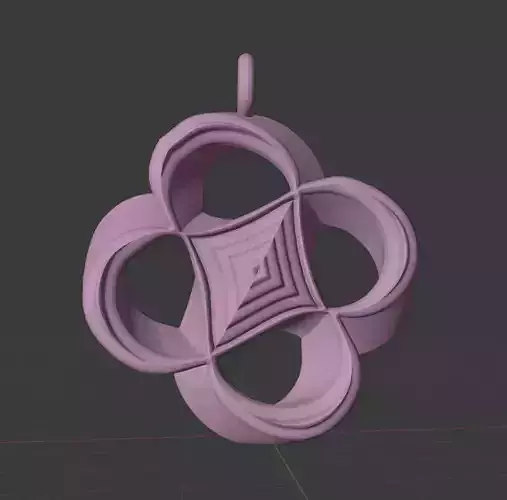1/5
Love becomes a flower in this pendant necklace design, ready for 3Dprint and production.
WIKI
Origins of symbolHeart-shaped peepal leaves were used in artistic depictions of the Indus Valley Civilisation: a heart pendant originated from there has been discovered and is now exhibited in Delhi national museum.[citation needed] In the 6th-5th century BC, the heart shape was used to represent the heart-shaped fruit of the plant Silphium,[1] a plant possibly used as a contraceptive.[2] Many species in the parsley family have estrogenic properties, and some, such as wild carrot, were used to induce abortion.[3] Silver coins from Cyrene of the 6–5th BC bear a similar design, sometimes accompanied by a silphium plant and is understood to represent its seed or fruit.[4]
Earliest use
The earliest known possible visual depiction of a heart symbol, as a lover hands his heart to the beloved lady, in a manuscript of the Roman de la poire, mid-13th century.The combination of the heart shape and its use within the heart metaphor developed at the end of the Middle Ages, although the shape has been used in many ancient epigraphy monuments and texts. With possible early examples or direct predecessors in the 13th to 14th century, the familiar symbol of the heart represented love developed in the 15th century, and became popular in Europe during the 16th.[5] Before the 14th century, the heart shape was not associated with the meaning of the heart metaphor. The geometric shape itself is found in much earlier sources, but in such instances does not depict a heart, but typically foliage: in examples from antiquity fig leaves, and in medieval iconography and heraldry typically the leaves of ivy and of the water-lily. One possible early use in the 11th century could be found in the manuscript, Al-Maqamat written by Al Hariri of Basra. The manuscript includes an illustration of a farewell greeting between two men while astride their camels, with the heart shape seen prominently over their heads.[6][not in citations given]
The first known depiction of a heart as a symbol of romantic love dates to the 1250s. It occurs in a miniature decorating a capital 'S' in a manuscript of the French Roman de la poire (National Library FR MS. 2086, plate 12). In the miniature a kneeling lover (or more precisely, an allegory of the lover's sweet gaze or douz regart) offers his heart to a damsel. The heart here resembles a pine cone (held upside down, the point facing upward), in accord with medieval anatomical descriptions. However, in this miniature what suggests a heart shape is only the result of a lover's finger superimposed on an object; the full shape outline of the object is partly hidden, and therefore unknown. Moreover, the French title of the manuscript that features the miniature translates into Novel Of The Pear in English. Thus the heart shaped object would be a pear; the conclusion that a pear represents a heart is dubious. Opinions therefore differ over this being the first depiction of a heart as symbol of romantic love.[7] Giotto in his 1305 painting in the Scrovegni Chapel (Padua) shows an allegory of charity (caritas) handing her heart to Jesus Christ. This heart is also depicted in the pine cone shape based on anatomical descriptions of the day (still held upside down). Giotto's painting exerted considerable influence on later painters, and the motive of Caritas offering a heart is shown by Taddeo Gaddi in Santa Croce, by Andrea Pisano on the bronze door of the south porch of the Baptisterium in Florence (c. 1337), by Ambrogio Lorenzetti in the Palazzo Publico in Siena (c. 1340) and by Andrea da Firenze in Santa Maria Novella in Florence (c. 1365). The convention of showing the heart point upward switches in the late 14th century and becomes rare in the first half of the 15th century.[7]
The scalloped shape of the now-familiar heart symbol, with a dent in its base, arises in the early 14th century, at first only lightly dented, as in the miniatures in Francesco Barberino's Documenti d'amore (before 1320). A slightly later example with a more pronounced dent is found in a manuscript from the Cistercian monastery in Brussels (MS 4459–70, fol 192v. Royal Library of Belgium). The convention of showing a dent at the base of the heart thus spread at about the same time as the convention of showing the heart with its point downward.[8] The modern indented red heart has been used on playing cards since the late 15th century.[9]
Various hypotheses attempted to connect the heart shape as it evolved in the Late Middle Ages with instances of the geometric shape in antiquity.[10] Such theories are modern, proposed from the 1960s onward, and they remain speculative, as no continuity between the supposed ancient predecessors and the late medieval tradition can be shown. Specific suggestions include: the shape of the seed of the silphium plant, used in ancient times as a(n) herbal contraceptive,[10][11] and stylized depictions of features of the human female body, such as the female's breasts, buttocks, pubic mound, or spread vulva.[12]
REVIEWS & COMMENTS
accuracy, and usability.





